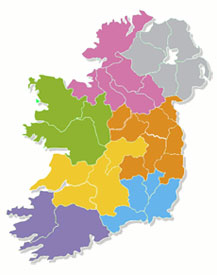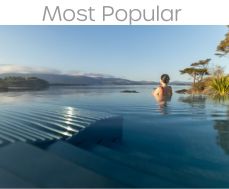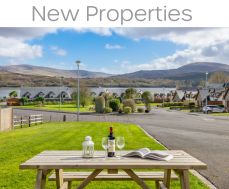SELF CATERING ACCOMMODATION GUIDE TO CORK CITY, IRELAND
ABOUT CORK CITY
Cork City and County have the perfect balance – an energetic, bustling "European city of culture" set in a county that has some of the most breathtaking natural beauty in Ireland. Numerous unspoiled mountains, lakes, rivers and beaches are just a short drive from Cork City centre, and even in the heart of County Cork, you are never more than an hour from the dramatic Atlantic coastline.
Cork City is Ireland's third city (after Dublin and Belfast) and is affectionately known as the "Real Capital of Ireland". Cork Harbour has long been recognised as an important seaport. It began as an island in the swampy estuary of the River Lee (hence the name Corcaigh which means a marsh), and gradually climbed up the steep banks on the either side. Some of the main streets are built over channels where ships dropped anchor over a century ago. Today the River Lee flows through Cork City in two main channels, so that you find yourself constantly crossing bridges perhaps while making your way to St. Patrick's Street, the main shopping street in the heart of the City. St. Patrick's Street went through a multi-million euro revamp in 2004 and has since won the title of "Ireland's best shopping street" on two occasions.
Along the South Mall, the business and financial centre of Cork, you will see large gateways at street level with steps leading from what was once an open flowing river channel. These buildings would have been boathouses, where merchants arrived at their warehouses by boat. Houses number 53 and 74 South Mall are examples of buildings that were built using Dutch materials and bricks, which would have arrived on-board ships that had traded in Holland.
Cork Jazz Festival
The Guinness Cork Jazz Festival, acclaimed as the friendliest jazz festival in Europe, has been running successfully and going from strength to strength for over 30 years. Thousands of avid followers flock to Cork city, on the October Bank Holiday weekend every year, to celebrate with old friends and make new ones. With over 1,000 musicians from all over the world, if jazz is your thing, Cork is the place to be.
Other Festivals in Cork City:
- Children's Literature Festival
- Cork St. Patrick’s Festival
- Cork International Choral Festival
- Murphy's Cork Film Festival
- Cork Mid Summer Festival
- Cork French Film Festival
Beaches in Cork
There are numerous beaches to choose from, all less than an hour's drive from Cork City.
Inchydoney
The Blue Flag beach at Inchydoney Island, just a few miles from Clonakilty and less than an hour from Cork City, is renowned not only as one of the most family friendly beaches in West Cork but also as one of the most beautiful. With vast expanses of sand, dunes and excellent surfing conditions there really is something for everyone. Car parking, toilets and access via ramps and steps. Bar and restaurant on-site. Lifeguards on duty in the summer season.
Owenahincha
Owenahincha is a popular family beach backing onto sand dunes where you can get the best of two beaches by taking the short walk over the cliffs to The Warren, Rosscarbery while taking in the incredible sea views. Owenahincha is only minutes away. Car parking and toilet facilities. Lifeguards on duty in summer season.
Youghal
The Seaside town of Youghal, less than an hour's drive East of Cork City, is now recognised as one of the South Coast's most popular resorts and has even been awarded an EU Blue Flag for the beach at Claycastle near the town centre. The destination of choice among many families, Youghal has something for all ages, from power-boating, to dinghy-racing, whale watching and even wreck diving to mention a few.
Golf in Cork
There are numerous award winning and challenging golf courses in Cork City and the surrounding areas. Some recommended golf courses include:
- Kinsale Golf Club Kinsale
- Old Head, Kinsale
- Fota Island Golf Club & Academy
- Cork Golf Club, Little Island
- Douglas Golf Club
- Harbour Point, Little Island
Fishing in Cork
Cork is acclaimed for its fishing with many people travelling for this reason alone. There are many areas to enjoy a high level of angling in Cork City and its sourrounding area. You can fish for wild Atlantic salmon on the River Blackwater. Or you can enjoy some coarse, game or sea fishing.
Activities in Cork City
Place to visit in Cork City and the surrounding area
Blarney
The village of Blarney has long been a tourist haven of the County of Cork. Over the past hundred years, millions have flocked to Blarney making it a worthy landmark and one of Ireland's greatest treasures. One of the best features of Blarney is its well preserved village square, around which the town has developed in Tudor style. In the evenings, the sound of music and laugher in the village is an invitation to come and mingle with locals and visitors alike.
Blarney Stone
Legend has it that if you kiss the Blarney Stone (Stone of Eloquence) you will never be lost for words again and everyone from Sir Walter Scott, a host of American Presidents and international entertainers have tried it. Visitors who flock to have a go can also spend the day wandering around the castle estate taking in Blarney Castle, Rock Close, Blarney House and Gardens.
Cobh
The town of Cobh (pronounced Cove) on the South Coast of County Cork is a colourful waterfront town that became the country's main emigration port following the Great Famine in 1846-1848. On Cobh's shoreline, stands a statue in memory of Annie Moore, the first immigrant to disembark on Ellis Island. Cobh is probably best known as Queenstown (as it was then known) the final port of call for the Titanic as she set sail across the Atlantic on her ill-fated maiden voyage.
Fota Island Wildlife Park
Ireland's only Wildlife Park, Fota Wildlife Park is among the most modern in Europe and offers a truly modern experience. A registered charity, Fota is set on almost 80 acres of rolling country side and is home to over 90 species of animals, many of which are endangered. It is widely regarded as a centre of excellence in the breeding of many species such as Cheetahs, Giraffe and European Bison. The other reason for the park's success is the freedom that the animals are given to roam freely within the park. A trip to Fota wildlife park is an ideal family day out, with numerous children's play areas, The Awacachi Tour Train around the park, picnic area's and on site cafe.
Kinsale
The beautiful coastal town of Kinsale is known as the Gourmet Capital of Ireland, restaurants in Kinsale pride themselves on their high reputation for culinary expertise and diversity of cuisine, so that you are guaranteed to have an enjoyable meal, what ever your taste. Among the town's top tourism attractions is the courthouse, which houses the Kinsale Regional Museum and exhibits mementos of the wreck of the ill-fated transatlantic passenger liner the "RMS Lusitania". Charles Fort is a fortification dating from 1670 which guards the entrance to the harbour and is probably the best known historical attraction in Kinsale. Located at Summercove, it is open all year, and regular guided tours are available.
Other places of Interest in County Cork:
Getting to Cork City
Rail
Cork Railway Station is located just off Railway Road. The Cork line serves many major Irish Towns including Dublin, Killarney, Tralee , Limerick, Waterford and Wexford.
Bus
Cork City Bus Station is located on Parnell St., just a short walk to Patrick's Street and the City Centre.
Sea
Brittany Ferries runs a convenient weekend scheduled ferry crossing from Cork to Roscoff in Brittany, France (from April to October). There is a bus service to meet guests on arrival and take them to the City Centre at a minimal charge.
Airport
Cork International Airport is located just 10 minutes drive outside the city, and operates daily flights to and from Britain and many other major European cities.
Places to Eat and Restaurants in Cork City
- Cafe Mexicana! The original a taste of Mexico
- East Village Contemporary venue with an extensive menu and an exciting bar
- Jacobs on the Mall contemporary style Restaurant with excellent service just a short stroll to exciting city night life.
- Pembroke Restaurant at The Imperial Hotel Modern setting with exceptional service
- Soho Bar and Restaurant Four levels of funky bar and restaurant options.
History of Cork City and Corks Famous Land Marks
St. Finbarr's Cathedral
St. Finbarr is the founder and patron saint of Cork City. He founded a monastery in the seventh century where the highly ornamental St. Finbarr's Cathedral now stands. The Cathedral has attracted the attention of visitors to Cork city since the time of the Vikings, who raided and burned the city, but returned in later years to settle and trade. The William Burges French Gothic style and it's memorable collection of spires in the skyline of the city make it a much photographed landmark.
Cork Opera House
The Cork Opera House is one of Cork City's most famous landmarks, there has been a theatre on the site of the present building since 1855. The original building, designed by Sir John Benson, had been constructed as a Fine Arts Hall for the National Exhibition of Ireland in 1852 before being relocated stone by stone to Nelson Square. The name however, has been changed over time, first it was Athenaeum, then Munster Hall, finally and presently The Opera House. In 1955 a fire destroyed the building (which had stood for over 100 years). A modern 1000 seat Opera House was built on the same site after 10 years of fundraising. The new building, which was designed by Murray O'Laoire Associates is said to have taken the architecture of the city into the 21st Century. The Theatre is now home to a busy programme of music and drama.
Heineken Ireland Murphy Brewery Ireland
In 1956 James J. Murphy (who's other business interests included the Midleton Distillery) founded the Lady's Well Brewery, which played a hand in bringing about a period of prosperity and employment in the city.
In 1862, the head brewer Edward Lane departed the company, and as a result Lady’s Well Ale was discontinued. James J. Murphy quickly established a strong trade for its porter. By the end of the nineteenth century Ireland also saw the growth of the railway network. This, coupled with an improvement in the quality of the countries roads, facilitated the transport of Murphy's products throughout the country.
In the late 1880s, the company decided to expand and remodel the brewery. This was seen as necessary in order to take advantage of improvements in brewing technology.
Trade actually increased during war years of the Second World War (or “The Emergency” as it was known in Ireland) , owing to the large scale mobilisation of thousands of men into the force and also because of money sent home by those who travelled to Britain for work or to fight in its armed forces.
The 1960's saw the introduction of the British company Whatney Mann who by 1967 had acquired 51% of the shares of James J. Murphy. By the early 1980's saw Lady's Well Brewery going into receivership and the take over by Heineken International Beheer B.V. By 2001 Murphy Brewery Ireland had changed its name and the brewery became Heineken.
Other interesting links:
- History of Cork
- UCC University College Cork
- Tourism Cork
- City Geol - an exhibition of what Cork was like in the early 19th and early 20th Century
- Cork Vision Centre
- Blackrock Castle Observatory
- Clonakilty
- Rosscarbery
- Heritage Ireland






